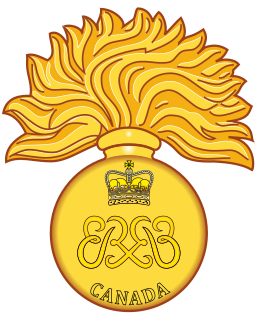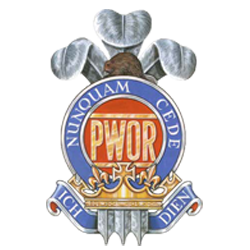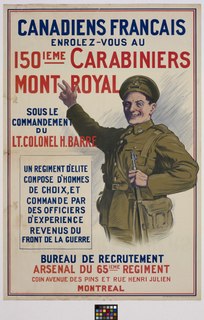Related Research Articles

Les Fusiliers Mont-Royal is a Primary Reserve infantry regiment of the Canadian Army.

The 12e Régiment blindé du Canada is a Canadian Army armoured regiment based in CFB Valcartier, on the outskirts of Quebec City. The regiment has both a Regular Force and a Primary Reserve unit. The 12e Régiment blindé du Canada's abbreviation is 12e RBC.

The Canadian Grenadier Guards (CGG) is a reserve infantry regiment in the 34 Canadian Brigade Group, 2nd Canadian Division, of the Canadian Army. The regiment is the oldest and second-most-senior infantry regiment in the Primary Reserve of the Canadian Army. Located in Montreal, its primary role is the provision of combat-ready light infantry troops in support of Canadian regular infantry. It is a Household Foot Guard regiment and also provides soldiers for public ceremonial duties, performing similar ceremonial duties to the Guards regiments of the British Army. This primarily entails mounting the guard on Government House, the Governor General's residence, and performing the "Changing the Guard" ceremony on Parliament Hill in Ottawa, a task it shares with Canada's senior Household Foot Guard regiment, the Governor General's Foot Guards of Ottawa. The Canadian Grenadier Guards is an allied regiment to the British Grenadier Guards.

The Royal Hamilton Light Infantry (RHLI) is a Primary Reserve infantry regiment of the Canadian Army, based at John Weir Foote VC Armoury in Hamilton, Ontario. The RHLI is part of 31 Canadian Brigade Group, which is part of 4th Canadian Division.

The British Columbia Regiment is a Primary Reserve armoured reconnaissance (recce) regiment of the Canadian Army; the regiment is subordinate to 39 Canadian Brigade Group of the 3rd Canadian Division. Established in 1883, it is the oldest military unit in Vancouver, British Columbia, Canada. It parades at the Beatty Street Drill Hall at the corner of Dunsmuir and Beatty in Downtown Vancouver. The regiment has been variously designated as garrison artillery, rifles, infantry, and armoured, but has been reconnaissance since 1965. It has received 41 battle honours in its history, and has been a unit of the Royal Canadian Armoured Corps since 1942.

Les Voltigeurs de Québec is a Primary Reserve infantry regiment of the Canadian Forces. It is located at the Quebec City Armoury in Quebec City, Quebec, Canada. The name of the regiment commemorates another older French-speaking Canadian militia light infantry unit, the Canadian Voltigeurs. The founder of the Canadian Voltigeurs, lieutenant-colonel Charles-Michel d'Irumberry de Salaberry, was the father of the two men who raised Les Voltigeurs de Québec. The regiment was formed in March 1862, with its headquarters in Quebec City, by the amalgamation into a regiment of eight independent Volunteer Militia Rifle companies. The first of these companies was originally raised in December 1861. Between 1862 and 1867 these companies were frequently disbanded, reformed and renumbered. In 1942 it provided an armoured regiment.

ThePrincess of Wales' Own Regiment (PWOR) is a Primary Reserve infantry regiment of the Canadian Forces.

The Brockville Rifles is a Primary Reserve infantry regiment of the Canadian Army. The unit is a part of the 33 Canadian Brigade Group, 4th Canadian Division. It is fifteenth in the order of precedence of Canadian Army Infantry Regiments.

Le Régiment de Maisonneuve is a Primary Reserve infantry regiment of the Canadian Forces. The regiment is Canada's twenty-sixth most senior reserve infantry regiment, and comprises one battalion serving as part of the Canadian Army Reserves.

The 150th Battalion, CEF was a unit in the Canadian Expeditionary Force during the First World War. Based in Montreal, Quebec, the unit began recruiting in late 1915 in that city and the surrounding district. After sailing to England in September 1916, the battalion was absorbed into the 14th, 22nd, 24th, and 87th Battalions, CEF, and the 5th Canadian Mounted Rifles. The unit officially ceased to exist as of February 15, 1918. The 150th Battalion, CEF had one Officer Commanding: Lieut-Col. Hercule Barre.

The Royal Regina Rifles is a Primary Reserve infantry regiment of the Canadian Army. Prior to 1982 the regiment was known as The Regina Rifle Regiment. The Royal Regina Rifles are part of 3rd Canadian Division's 38 Canadian Brigade Group.
The 244th Battalion, CEF was a unit in the Canadian Expeditionary Force during the First World War. Based in Montreal, Quebec, the unit began recruiting in the spring of 1916 in Montreal and the surrounding district. After sailing to England in April 1917, the battalion was absorbed into the 23rd Reserve Battalion, CEF later that month.

The 5th Battalion Canadian Mounted Rifles were a mounted infantry unit of the Canadian Expeditionary Force (CEF) during World War I. The unit was raised from volunteers of the 7th and XIth (Canadian) Hussars from the Eastern Townships of Quebec.

The Royal Rifles of Canada was a rifle regiment in the Canadian Army and fought alongside The Winnipeg Grenadiers in the Battle of Hong Kong during World War II. In November 1966, it was reduced to nil strength and place on the Supplementary Order of Battle.

The Victoria Rifles of Canada was an infantry regiment of the Canadian Army that originated in Montreal, Quebec, on 22 January 1862, as The 3rd Battalion Volunteer Militia Rifles Canada. The regiment went through several changes of designation throughout its history. It was redesignated as the 3rd Battalion, The Victoria Volunteer Rifles of Montreal on 18 July 1862; as the 3rd Battalion Victoria Rifles of Canada on 5 December 1879; as the 3rd Regiment Victoria Rifles of Canada on 8 May 1900; as The Victoria Rifles of Canada on 29 March 1920; as Victoria Rifles of Canada on 15 November 1934; as the 2nd (Reserve) Battalion, Victoria Rifles of Canada on 7 November 1941; and finally Victoria Rifles of Canada on 1 June 1945. It was reduced to nil strength and transferred to the Supplementary Order of Battle on 5 March 1965.
The 23rd Reserve Battalion, CEF was an infantry unit in the Canadian Expeditionary Force during the First World War.
The 1st Battalion, Canadian Mounted Rifles, CEF, was an infantry battalion of the Canadian Army. Raised for service during the First World War as part of the Canadian Expeditionary Force (CEF), it was formed in November 1914, in Brandon, Manitoba. Originally a mounted infantry unit named the 1st Regiment, Canadian Mounted Rifles, CEF, which was expanded, following its rerolling and dismounting as an infantry unit, by absorbing other units of the Canadian Mounted Rifles.

The 8th Battalion, CEF, was an infantry battalion of the Canadian Expeditionary Force during the Great War. The battalion was authorized on 10 August 1914 and embarked for Great Britain on 1 October 1914. It disembarked in France on 13 February 1915, where it fought as part of the 2nd Infantry Brigade, 1st Canadian Division in France and Flanders until the end of the war. The battalion was disbanded on 15 September 1920.

The 46th Battalion, CEF, was an infantry battalion of the Canadian Expeditionary Force during the Great War. The 46th Battalion was authorized on 7 November 1914 and embarked for Britain on 23 October 1915. On 11 August 1916 it disembarked in France, where it fought with the 10th Infantry Brigade, 4th Canadian Division in France and Flanders until the end of the war. The battalion was disbanded on 30 August 1920.
The Oxford Rifles were an infantry regiment of the Non-Permanent Active Militia of the Canadian Militia. In 1954, they were amalgamated with The Canadian Fusiliers to form the reserve battalion of the Royal Canadian Regiment.
References
Meek, John F. Over the Top! The Canadian Infantry in the First World War. Orangeville, Ont.: The Author, 1971.